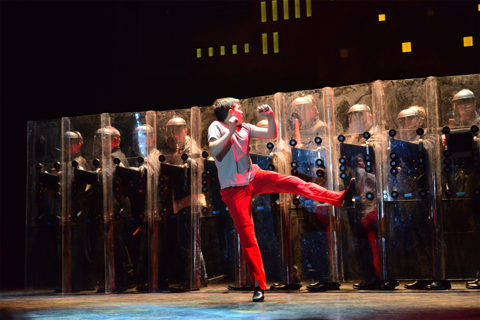 (Photo by Gary Ng) |
Ballet is not for pussies—anyone who’s watched its muscled professionals leap and spin can attest to that. But it’s 1984, and the men in Billy’s English working class mining town are mired in the usual gender and class stereotypes. Still, eleven year-old Billy dances in Billy Elliot, the Musical, a show based on the 2000 film and on stage now in a regional premiere in Ogunquit. Is this musical adorable, rife with dancing children, and fundamentally uplifting? Yes, but it also features bloody union battles; a huge, red-eyed Margaret Thatcher effigy; and an impressive young lead who conveys the aggressive athletic prowess, frequent rage, and overall balls of Billy’s dancing: Billy is a ballet musical that is likewise not for pussies. It receives a virtuoso production here, recreated specifically for the venerable Ogunquit Playhouse, under the direction of BT McNicholl.
While his town is consumed with a historic coal miner’s strike, motherless Billy (played alternately by Noah Parets, who performed the night I attended, and Sam Faulkner) wanders from his brutish boxing class into ballet taught by the jaded, twiggy redhead Mrs. Wilkinson (Anastasia Barzee). When he shows a talent for chaîné turns, Mrs. Wilkinson takes him under her wing, suggesting that he audition for London’s Royal Ballet School. Billy’s haggard, widower Dad Jackie (Armand Schultz) isn’t charmed by the idea, and to dance, Billy contends with much small-mindedness and hard love in his family and town.
The ethos and heritage of this community receive special attention at the hands of scenic designer Campbell Baird, who had the unusual opportunity to visually redesign the production. This show opens with newsreel clips of miners and Thatcher projected onto a clothesline’s white sheets, which soon rise to reveal a simple cutout backdrop of row houses and mine towers. Just as the townspeople’s class identity is never far from their minds, this horizon is often visible, as Baird’s elegant modular set moves us between Billy’s modest home, the run-down community center, and the streets.
McNicholl’s fine ensemble characterizes the town’s miners, cops, mothers, and wives with humor and agility. Billy’s grandmother (Dale Soules) gives tough, comedic, and haunting voice to a song about her abusive late husband’s dancing, and Billy’s sensitively portrayed father is at once stoic, loving, and volatile. Billy, in Parets’s expressive hands, shares his family’s no-bullshit doggedness; what distinguishes him from them is less his pirouettes than his bewildered but fearless, nonjudgmental curiosity. Parets nails this, particularly in his bemused encounters with Barzee’s richly laconic Mrs. Wilkinson, and with his young cross-dressing friend Michael (Alec Shiman, with Mick Jagger charisma and unaffected ebullience for fringe and red tap shoes).
And the dancing is often jaw-dropping. Interesting choreography (recreated and adapted by Adam Pelty) interweaves the physicality of clashing miners and cops with that of their dancing children (played by skilled young dancers who pretend entertainingly to dance badly). Even the minimalist bits delight, as when the men’s ensemble, playing a phalanx of cops, twitches, picks noses, and does jazz hands to the rhythms of syncopated percussion and slide whistles.
 MOVEMENT IN CONTEXT Design and choreography ripen the drama in Ogunquit production (Photo by Gary Ng) |
And Parets is phenomenal, both vulnerable and fierce, literally shrieking in his defiant “Angry Dance.” He convincingly portrays Billy’s development from latent talent to focused dancer, and in a remarkable pas de deux with his older self (Stephen Hanna), he executes powerful leaps and turns, then hooks into a wire, rises, and spins so fast that I was astonished he can even walk straight afterward, let alone execute an accomplished final chain of turns to the edge of the stage.